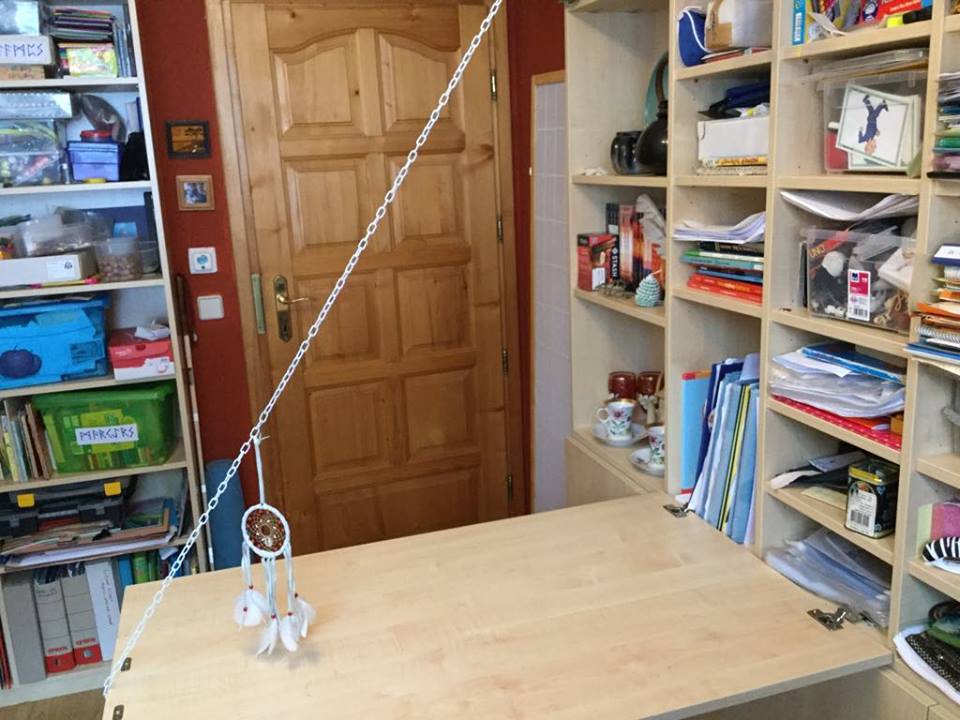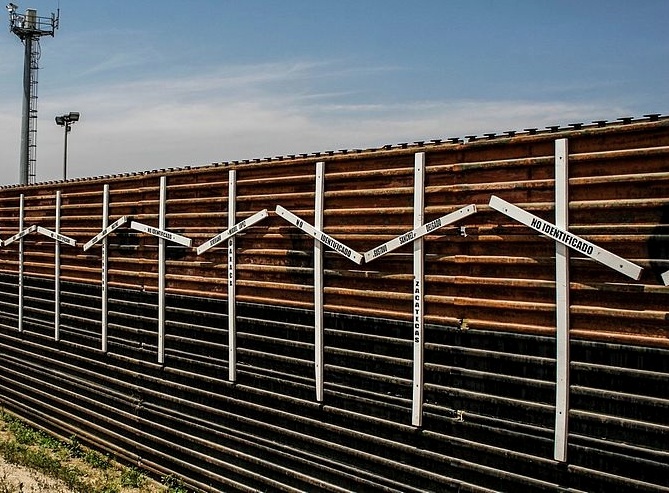Doing poverty well: How to actually deal with clutter
/I’ve run across at least a dozen blogger responses to Marie Kondo’s new Netflix series on fighting clutter for a less stressful lifestyle. Several of these have already pointed out that the show is deeply classist.
I’m not going to belabor the point. It is. Getting rid of everything you haven’t used recently and assuming you can just buy one later if you need it is a choice only viable for the economically privileged. Berating people who don’t currently have or recently didn’t have that privilege for “clutter” is classist. And environmentally unsustainable to boot.
These are the shelves directly on my bed and they combine active bookshelf with cosmetics and jewelry stations, spiritual practice supplies and things I really need to hide from my children. - Image by Arie Farnam
I’m sure the show and its advice is helpful to some. There are people who senselessly horde or acquire stuff without planning or a focus on reusing and upcycling. There probably are middle class people who have a lot of junk they really legitimately don’t need and will never use. The show may well be helpful to them and might result in less stress in their lives.
That’s a good thing and if there was any indication of compassion or understanding that we don’t all have this luxury, I wouldn’t be even mildly irritated at the show. It’s the support of the bubble of privileged comfort that some in the western middle class, which is actually in the top one percent of the world’s wealthiest people, dwell within that bothers me and a few other bloggers. The show doesn’t mention that it is only designed for a very select group, because some in that group don’t feel comfortable when they are reminded of their privileged status in the world. It’s just a thing you don’t say if you want their approval ratings..
The show irritates those of us who stumble across it, but don’t fit into its demographic. And yes, some of us have a broad definition of the word “family” when it comes to both the dinner table and Netflix family passwords and thus some of us occasionally have Netflix.
But I digress. This post isn’t so much about the show as it is about solutions for the rest of us.
You see, clutter is a problem for those with modest means. In fact, it is likely to be a bigger problem for us than it is for the middle class.
First, let me define “us.”
Some will rightly complain that I’m not “poor enough” to talk about doing poverty well. I live a reasonably comfortable lifestyle after all. My children have never gone to bed hungry, except for those couple of nights when they went on strike from regular food in a desperate bid to force a one-hundred-percent noodle, ketchup and candy diet that simply didn’t pan out with Mama bear in the kitchen. So what am I complaining about?
I’m not. Complaining, that is.
My family lives well below the US poverty line in a middling Eastern European country, where we’re actually pretty middle class. I grew up more genuinely poor and in my twenties I went through some winters where cabbage and potatoes were really all I could afford. But my point isn’t to bemoan “poverty.” I, in fact, hold that if most of the world lived close to our consumption level, we could be environmentally sustainable and comfortable enough.
My goal isn’t to become wealthier but rather to live better with what we have. And dealing with clutter is part of that. My solutions are just different from Marie Kondo’s.
When you live close to or below what has been arbitrarily (but in this case handily) designated as the US poverty line, you are in a situation where you can usually buy one small item that you need at a time or save up for a larger item, but you can’t simply acquire what you need when you need it. If you have lived this way for long, it is unlikely you “throw away” anything that isn’t actually useless. You most likely have a running mental list of those who could use, recycle, upcycle or re-enliven something you no longer want.
This is my office and writing nook. Shelves hold reference materials, taxes and official documents, daily office supplies, electronics parts, paper, tea pot and a few display books. There is a fold-out table that hides my ESL teaching center and doors on the bottom cover the household herbal pharmacy and herbalist supplies. - Image by Arie Farnam
You may well store a lot of things that you don’t need immediately. Your first thought when finding an odd castoff mechanical part is more likely to be, “I wonder what this could be useful for?” than “Why is this old thing still around?” You plan and save and put together what you need.
And there’s another thing. Your entertainment is more likely to be self-made. You don’t go on distant vacations. If you go on vacation, it usually requires a lot of stuff—like tents, sleeping bags, cooking equipment and so forth. And if you don’t go on vacations, you have other interests, many of which entail making things, which requires supplies and equipment.
Your job likely also requires supplies. You likely fix clothing, cars, furniture and other things when they are broken rather than throwing them out, which means your home may well have the necessities for sewing, auto work and carpentry. You are actually more likely than the middle class to own your own cement mixer, sewing machine, towing cables or power saw. I own all four. Lacking a home of your own, you may not own these things, but you very likely own a sewing kit and a set of tools, no matter how makeshift.
And all these things are clutter when piled up into a small home, apartment, car, backpack or whatever you live out of.
Does that mean you should take Marie Kondo’s advice and get rid of anything you haven’t used recently and then every object that does not give you joy. The toilet plunger would be top of the list for me… and how would that go?
The worn-out clothes I garden in aren’t comfy old favorites. They are very specifically, clothes I hate that I expect will be torn and dirty beyond repair in a rough season or two. My cracked mismatched dishes don’t bring me joy. The set of nice dishes brought out only for holidays and adult company do. And the reason they are still nice and joyful is that we don’t use them for everyday.
Nope. That method isn’t going to work for dealing with our clutter.
This is a topic near and dear to my heart. I live in a small, compact house. There isn’t an inch of space that isn’t in planful use. I run a business out of my home that requires me to meet clients in my home daily. My home has to be neat and tidy. Local social norms require it for such a business. Beyond that, I’m ninety percent blind and a pile of junk is truly a problem for me to wade through. Things need to have places.
But all the above still applies. I cook all of my family’s meals from scratch because instant food that won’t kill you is expensive. Thus I have a fully stocked kitchen and a jam-packed pantry. I also have a vegetable garden and that means I have a shed full of tools and supplies, window sills full of seedlings and a cellar and freezers full of produce.
My business requires extensive teaching supplies. I also have kids and they have stuff. We live hours from the nearest English-language library, so we have our own library shelves, particularly full of children’s books. Modern technology has meant some slimming of our bookshelves, DVDs and CDs but subscription services cost money and reference books get used a lot around here.
Beyond that, there is my mental health. Like most people in my situation, I don’t have relaxing vacations or spa treatments or even weekends away. I have interests instead. I study medicinal herbs and recently I’ve taken up candle and soap making. These also require stuff—materials, supplies and storage space.
So it goes for many of us. I go through my pantry regularly from top to bottom every six months and reorganize a bit every month or two. I am always weeding through clothing hordes, swapping out tattered and laundry-shrunken clothes for clothes from the hand-me-down network or bought at an amazing second-hand shop we hit on a trip two years ago that finally fit my kids.
This is my ESL teaching center. The messiest paper part is covered by this fold-out table which can be lowered to accommodate students or paperwork as necessary. - Image by Arie Farnam
My kids each have a few drawers for the clothes currently in use. There are are also three bins in their closets that contain clothes. The lowest, easiest-to-reach bin contains still-useful, only mildly tattered clothes that are too small for my kids. These are fed back into our hand-me-down network on a regular basis. The second bin contains off-season clothes—winter clothes in summer, summer clothes in winter. The final bin contains the hoard of clothes that don’t yet fit my kids. Most of these are a year or two from fitting but a few particularly nice bits are being hoarded for a distant future.
That’s how I handle clutter. Or at least it’s one example.
Mostly handling clutter well when you live the way I do means organization, labeling and taking periodic inventory..
I have bins for tools, wire, glue, rope, rubber bands, nails, small boxes, plastic bags, art supplies and plenty of other categories. The skeptical will inevitably remark that there is a lot there that we will never actually use. It’s true that about a third of it eventually gets cycled out when its usefulness is determined to have been overestimated. But all of these things are things acquired free, extremely cheaply or by mistake, as everyone sometimes acquires things. We don’t seek them out but when they come in, if they might be useful, we store them rather than fill the landfill.
Once I observed a middle-class American doing an art project and gaped in surprise at the clean-up, which was apparently routine. Not only were the drop clothes not washed and hung to dry. They were simply bundled with all the scrap material inside and tossed into the garbage can—unused paints, barely opened glue tubes, brushes and all. In my world, only a few stray scraps would have ended up in the garbage, and even then only if they couldn’t conceivably become confetti, decoration for children’s projects or… fire starter.
Yup, there’s a bin for tinder as well, containing candle drippings, soiled wax baking paper, nutshells and paper scraps free enough of chemicals to be deemed compost-safe once burned.
The crucial thing is to be able to find what you need when you eventually do need it. That’s where storage systems, labels and bins come in. Last year, I had what is likely to be a once-in-a-lifetime opportunity in my class. I got to design my own work space and actually see it built. The photos in this post are from my new space, which features many small shelves and storage compartments. Some of the storage has doors to cover it. But much of it does not, in order to allow quick and handy access.
These are my teaching supplies for both homeschooling and my ESL classes for children. Some bins have been labeled with Norse Runes because of a memorization project I was doing. They ended up coming in handy keeping children out of bins they shouldn’t be dumping out.
I learned valuable organizational principles during this process and here is my advice to rival Marie Kondo’s.
Before you shop, always take inventory and organize:
Categorize items by type and label clearly.
Store categories near where they are most used. Have at most two places where the same category is stored. (Glue may be in the wood shop as well as the office.)
If an item has a single use only, store it with the items used with it rather than with it’s type. (Gardening sheers are stored with gardening things, not with scissors.)
Use up one package or container of a material as much as possible before opening another, even if it isn’t convenient. Recycle or re-purpose the packaging.
Be creative in finding storage space. Not everything must be stored in heated rooms of your home. Building raised beds or hollow kitchen benches with lids for seats will often dramatically increase your storage space. If you are able to build your own shelves, carefully plan out what you need to store where and plan the depth, width and height of shelves with the storage containers you have and are likely to have in the future in mind.
While building a separate pantry or walk-in closet may seem like it significantly shrinks your living space, if you can line it with shelves and store what you need inside it, it will significantly decrease clutter and increase the usability of the space you have.
Designate a storage space for repourposed materials like boxes, bags, building scraps and paper supplies. Containers which the given material won’t quickly overflow out of are ideal. When space is limited, consider carefully the storage needs of given materials. Paper boxes must be kept in a dry place, but heat and cold don’t matter. Cans of paint can tolerate occasional moister but cannot tolerate great differences in temperature or any frost. Some materials, like cloth, are susceptible to pests.
This is half of my herbal pharmacy which is normally covered by doors. - image by Arie Farnam
Getting rid of things you don’t need
Certain types of supplies tend to accumulate more quickly than others. Cardboard boxes and water-proof bags (usually plastic up until recently) are essential for many activities and expensive to buy when needed. They can accumulate quickly, depending on your activities. Keep a supply of a dozen smaller boxes and several larger boxes. Keep a plastic bag full of plastic bags of similar size. If you have more than that and don’t need them for a specific reason, recycle those that are getting tattered.
Keep spare parts together. If you really have the skills to use a spare part to fix something later, it is okay to keep spare parts which are in good condition. Recycle parts that are damaged or which you would not be able to use given your skills and tools.
Fix broken tools when possible. If it is not possible to fix a tool, it is best to separate it into materials to be recycled.
Store craft, cooking and gardening supplies well, usually in air-tight containers. Don’t throw out half-full packages unless the contents are damaged. If the packaging is damaged, repackage and store for later use. If the material itself is damaged, dried up or spoiled, dispose of it in the most conservationist way possible.
The hierarchy of disposal should be: 1. Repair/reuse/repurpose, 2. Channel to those who can repair, reuse or repurpose in your network, 3. Give to charity, 4. Use as or give to others for animal feed, 5. Use as compost, mulch or construction material, 6. Burn as fuel, 7. Breakdown and recycle, 8. Landfill. An item that you don’t need or can’t use starts at the top of the hierarchy. You assess its possibilities for usefulness and put it in the first category in which it can be truly useful.
The upper part of the hierarchy is focused on disposal which will benefit someone else. Some of this may be actual charity. Much of it is not charity at all. One of the key elements of doing poverty well is to have a hand-me-down network, and hand-me-downs are not all clothes by far. Lettuce scraps are a welcome hand-me-down to a chicken owner or gardener.
There is often not a direct return of the favor but those who give into such a network also receive when others have a surplus or an unneeded-but-still-useful item. I calculate that about 30 percent of my family’s food supply comes free or very cheaply from our network and it is all top quality organic products. This is one of the main reasons I can claim to live quite well below the US poverty line. As a result, not a day goes by when I don’t find myself considering if an item or materials I need to dispose of could be used by someone else in my network.
The other methods in the disposal hierarchy get as much residual use out of materials as possible and minimize both the costs of acquiring other materials and the harm to the environment. There is a stereotype that poor people don’t care about environmental issues. Sometimes people have been misled to misunderstand what “environmentalism” means, but people of modest means are also more vulnerable to ecological disruption, whether we are urban or rural dwellers. In the same way that you feed and protect your hand-me-down network for your own benefit, it is in your interests to nourish and protect your environment.
Restocking
When you live with modest means, it is good to be on the look-out for items or materials that you may need in the future that are being offered free or extremely cheaply. Stocking this way is an imperfect science or even an art. You will inevitably misjudge some things and end up storing something you will never need. The most important consideration is making sure that getting rid of something will not be an undue burden before you acquire it. Secondly, think of where you will store it while you are considering acquiring something. And finally, make sure there is actually a reasonable likelihood you’ll need what you’re acquiring. Ideally you’ll turn down far more than you bring in.
Each person’s needs are quite different. If your job requires you to dress in an expensive fashion, you may have to store a fair amount of clothing to make it work. This is different than simply hording clothes for fun, although that can be a hobby for some. Inventory and reassessment still applies, unless you consider this a hobby.
When new disposable items come in, place them UNDER or BEHIND older or half-used equivalents and use the older and half-used equivalents first. (If you acquire new tape very cheaply before your supply has run out, do not place it on top of the old supply.)
Some people will become so good at this that they will become a network hub and acquire things they don’t personally need in order to feed them into their network. As with many other parts of this barter economy, there is a fuzzy line between the skilled networker and the out-of-control pack rat. The difference will be in both organization and generosity.
I hope my experience may be helpful, whether you are voluntarily or involuntarily living on modest means. These are some of the ways to both contain clutter and organize materials to be both sustainable and useful.
Best wishes to all!




















